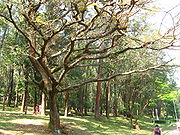
Copaiba
Encyclopedia

Genus
In biology, a genus is a low-level taxonomic rank used in the biological classification of living and fossil organisms, which is an example of definition by genus and differentia...
Copaifera
Copaifera
Copaifera is a genus of flowering plants in the legume family, Fabaceae.The scientific name means "copal-bearer" , since economically important resins and essential oils can be acquired from them. They are also important for production of biodiesel and wood, especially Copaifera langsdorffii...
). The thick, transparent exudate
Exudate
An exudate is any fluid that filters from the circulatory system into lesions or areas of inflammation. It can apply to plants as well as animals. Its composition varies but generally includes water and the dissolved solutes of the main circulatory fluid such as sap or blood...
varies in color from light gold to dark brown, depending on the ratio of resin
Resin
Resin in the most specific use of the term is a hydrocarbon secretion of many plants, particularly coniferous trees. Resins are valued for their chemical properties and associated uses, such as the production of varnishes, adhesives, and food glazing agents; as an important source of raw materials...
to essential oil
Essential oil
An essential oil is a concentrated hydrophobic liquid containing volatile aroma compounds from plants. Essential oils are also known as volatile oils, ethereal oils or aetherolea, or simply as the "oil of" the plant from which they were extracted, such as oil of clove...
. Copaiba is used in making varnishes and lacquer
Lacquer
In a general sense, lacquer is a somewhat imprecise term for a clear or coloured varnish that dries by solvent evaporation and often a curing process as well that produces a hard, durable finish, in any sheen level from ultra matte to high gloss and that can be further polished as required...
s.
The hydrocarbon
Hydrocarbon
In organic chemistry, a hydrocarbon is an organic compound consisting entirely of hydrogen and carbon. Hydrocarbons from which one hydrogen atom has been removed are functional groups, called hydrocarbyls....
s in copaiba are terpene
Terpene
Terpenes are a large and diverse class of organic compounds, produced by a variety of plants, particularly conifers, though also by some insects such as termites or swallowtail butterflies, which emit terpenes from their osmeterium. They are often strong smelling and thus may have had a protective...
s, which are made by plants from isoprene
Isoprene
Isoprene , or 2-methyl-1,3-butadiene, is a common organic compound with the formula CH2=CCH=CH2. Under standard conditions it is a colorless liquid...
, a "five-carbon-atom building block, so they always contain carbon atoms in multiples of five. Pinene
Pinene
Pinene is a bicyclic monoterpene chemical compound. There are two structural isomers of pinene found in nature: α-pinene and β-pinene. As the name suggests, both forms are important constituents of pine resin; they are also found in the resins of many other conifers, as well as in non-coniferous...
is one of several useful 10-carbon terpenes. It is commonly known as turpentine
Turpentine
Turpentine is a fluid obtained by the distillation of resin obtained from trees, mainly pine trees. It is composed of terpenes, mainly the monoterpenes alpha-pinene and beta-pinene...
. Heated up, terpenes break down into methanol
Methanol
Methanol, also known as methyl alcohol, wood alcohol, wood naphtha or wood spirits, is a chemical with the formula CH3OH . It is the simplest alcohol, and is a light, volatile, colorless, flammable liquid with a distinctive odor very similar to, but slightly sweeter than, ethanol...
(CH3OH) and other simple compounds useful for fuel and as raw materials in the chemical industry."
Copaiba is also a common name for several species of trees of the legume family native to Tropical Africa and North and South America.
Uses
Copaiba is particularly interesting as a source of biodieselBiodiesel
Biodiesel refers to a vegetable oil- or animal fat-based diesel fuel consisting of long-chain alkyl esters. Biodiesel is typically made by chemically reacting lipids with an alcohol....
, because of the high yield of 12,000 liters per ha. The resin is tapped from standing trees, with an individual tree yielding 40 liters per year.
Medicinally, copaiba has been used to treat stomach cancer and ulcers. It has demonstrated antifungal properties, among a wide variety of ascribed medicinal properties.
Copaiba is also used as an artist material, especially in oil paint recipes and in ceramic decoration. Mineral painters use a medium made of copaiba, turpentine and lavender to mix with their minerals for adhesion to ceramic vessels before kiln
Kiln
A kiln is a thermally insulated chamber, or oven, in which a controlled temperature regime is produced. Uses include the hardening, burning or drying of materials...
firing. Copaiba makes a good medium for oils and helps with both adhesion and quality of shine.

